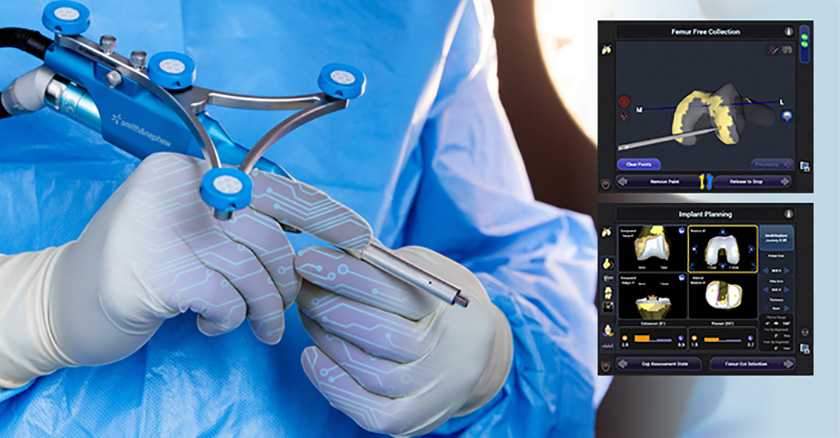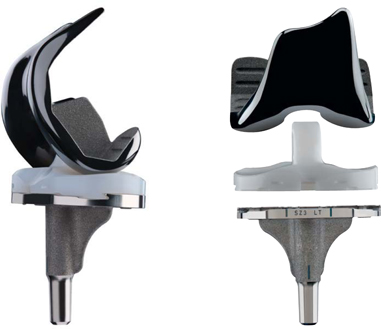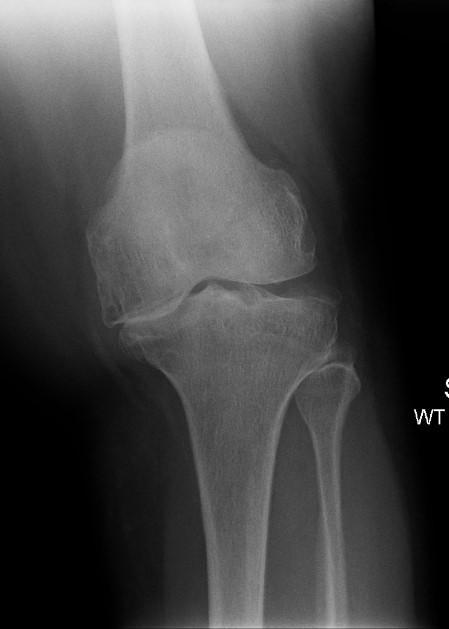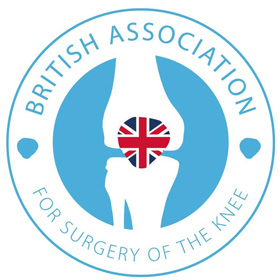
NAVIO Robotic System

The Journey 2 BCS Knee – designed to restore a more normal feeling joint.

Arthritic Left Knee with loss of cartilage and deformity before replacement surgery.

After Knee replacement, the joint is restored to its original position and the deformity is corrected with the knee now straightened.
NAVIO Robotic Total Knee Replacement
What happens during a ‘traditional’ total knee replacement?
Knee replacement surgery involves removing the damaged joint surfaces (i.e. the worn cartilage and bone), and replacing them with artificial joint components.
In the past, the surgeon would make a big incision down the front of the knee, and then use an instrument called a jig, to mark out the incisions needed to cut away the damaged bone and cartilage from the end of thigh bone [femur], and the top of the shinbone [tibia].
Metal components were then placed on the end of the femur and the tibia, separated by plastic spacers. The surgeon would then close the incision site with stitches and staples.
Much like a tailor cutting cloth using a pattern, this traditional technique relies on tools, good placement and surgical skill, but it has its limitations.
The problem with total knee replacements carried out in this traditional manner, has always been the accuracy of placement of the components. If they’re not perfectly aligned, they have a tendency to wear faster and have been associated with less desirable outcomes, such as pain and stiffness. It is also difficult to balance the ligaments around your knee if the bones are cut inaccurately.
What happens during robotic knee replacement surgery?
Robotic surgery has greatly advanced what we can achieve at the time of a total knee replacement.
It’s important to say that it’s not a robot that’s operating – the robot guides the surgery and I’m in complete control.
The robot enables me to minimise the amount of bone removed, and it means I can put the replacement joint in really, really accurately. A special probe that’s part of the operating system process creates a 3D, real-time roadmap of the joint surfaces, so I can precisely trim the knee, ensuring the replacement components will fit beautifully.
The surgery is tailored to fit you during the operation and there is no need for extra CT scans .
I can balance the tension of the soft tissue around the knee in real time, with the aim being that the movement and glide of the femur on the tibia will feel very, very natural once you’re healed.
I’ve been so impressed with the outcomes of my patients who undergo robotic guided surgery that it’s been over three years since I last performed a ‘traditional’ knee replacement.
I’m considered to be one of the leading experts in robotic assisted knee replacement surgery, and I help guide international research groups in Europe, the Middle East, and Africa. I’m also a member of the Computer Assisted Orthopaedic Surgical Association, which is part of the British Orthopaedic Association.
Why Use Robotics?
Knee replacement surgery requires great accuracy. In the past, traditional surgical techniques, which involved a surgeon making incisions using cutting blocks or guides, wasn’t entirely accurate.
Unfortunately, a sub-optimally placed knee replacement, might have led to a persistently grumbly knee or a knee replacement that wore out faster.
Robotic knee replacement surgery has thankfully revolutionised the outcomes of knee replacement surgery.
I carry out all my knee replacements using robotic techniques – 90% of my patients describe their new knee as being ‘excellent’, and we can anticipate that this kind of knee replacement is likely to last in excess of 20 years.
Robotic versus custom knee replacement surgery.
You may have been researching knee surgery online and are wondering what is the difference between ‘robotic’ surgery and ‘custom’ knee replacement surgery?
When we’re putting implants into patients, we need to know that implant is going to work really well mechanically, that it has a very long history of working in thousands of patients (i.e it’s not a novel implant that isn’t tried and tested), and it also needs to be put in as accurately as possible.
True custom knee replacements are effectively a new design for each and every patient, and the very nature of novel design means there isn’t the reliability of rigorous testing (because each one is different).
You may have read that custom knee replacements are uniquely tailored to the patient. In reality, our tried and tested robotic surgery system gives us enormous flexibility to be able to tailor the replacement to you with great accuracy. In other words, we get the benefit of it being a highly accurate procedure using implants that have a very long history of surgical success.
I’m sure it won’t be long before robotic knee surgery is a technique utilised for all knee replacement surgery, but I’m very pleased to be able to offer to them to my patients now.

NAVIO Robotic System

The Journey 2 BCS Knee – designed to restore a more normal feeling joint.

Arthritic Left Knee with loss of cartilage and deformity before replacement surgery.

After Knee replacement, the joint is restored to its original position and the deformity is corrected with the knee now straightened.






